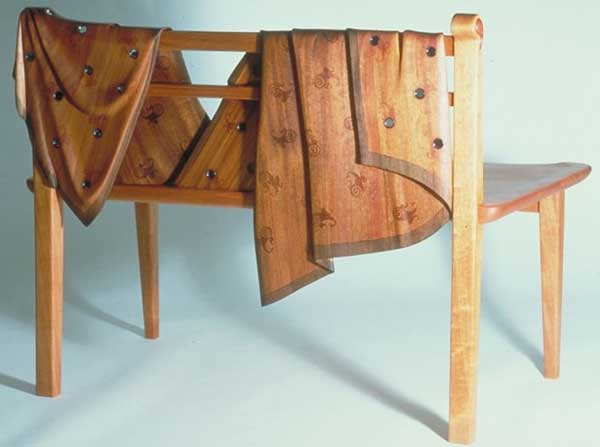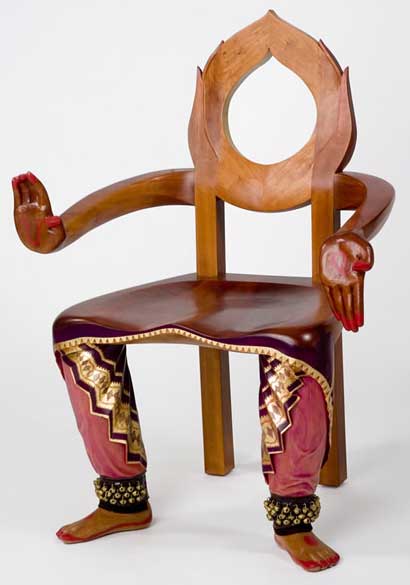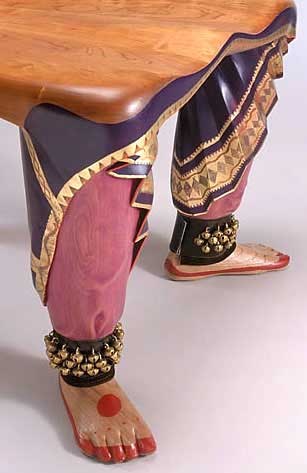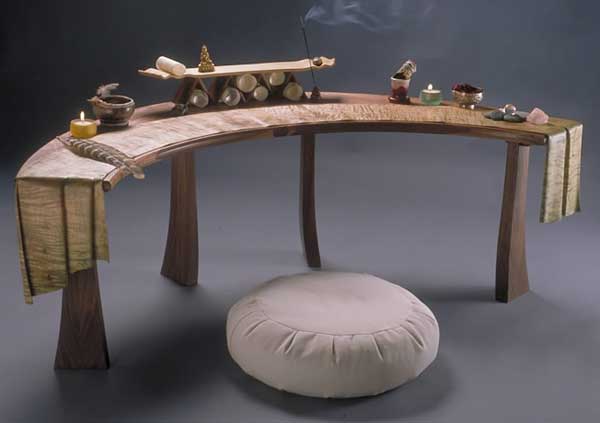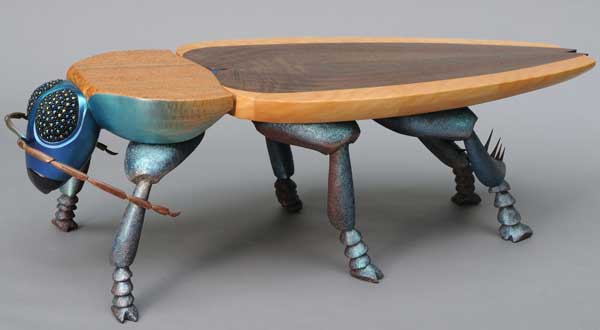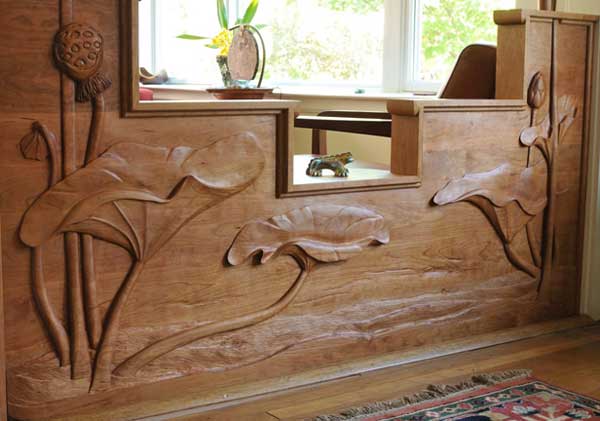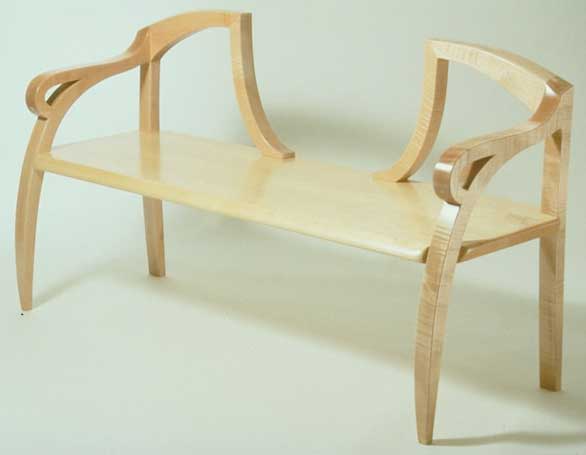
Sabiha Mujtaba has always put curves into her work, from when she was a sculptor in England, to her work now as a studio furniture maker and designer in Atlanta, Georgia.
Early on, part of that was influenced by the work of furniture maker Judy McKie – “she was the first woman woodworker I’d seen,” Sabiha said. “I was mesmerized by her animal, organic pieces, and I wanted to emulate that.” – but, before long, Sabiha came into her own style.
She became a woodworker rather than a sculptor due to a job opportunity that arose when her family moved to Atlanta from England. Sabiha apprenticed for a few years at Sutherland Studios, doing whatever needed doing, and “fell in love with it: with the grain, with the patterns. The physicality of the wood was so exciting to me.”
After striking out on her own in the mid 1980s, she did basic commission work – tables, cabinets and such – for a while, and gradually started adding more of her own style. These days, the majority of Sabiha’s work is commissions that she designs with her clients.
“My pieces have an anthropomorphic style, or an animal movement,” she said. For example, she sees the arms of her bench “I’m There and You’re Here” as looking like “an animal bending its leg up. I see it more than other people do.”
What she hadn’t seen, until the past six to eight years, was cultural references in her work. “Initially, I haven’t used it consciously,” she said. “There may have been a subconscious reference somewhere. People have told me in the past that some of my work has a South Asian feel.”
A few years ago, after started to incorporate what she calls “folded cloth” – made from wood – into her work, Sabiha started thinking about the cultural references of cloth. “In ritualistic expressions, in rituals people have in their lives,” cloth is present, she said. For example, cloth may hang over a religious altar, “or you have a softness of cloth hanging over something. It’s softening, and has an appeal to people.”
Sabiha’s “cloth folds” are a trompe l’oeil trick, made from wood, in pieces like “Bench with Sindhi Shawl.” “It’s basically a carving technique,” she said. In addition, she “learned how to put the joinery together so it looks like it’s flowing from one plane to another plane. You have to hide where you do the joints in a carved piece.”
She used the technique in her Bharatanatyam Dancer chair, a piece that came about after she had been thinking about how “cloth folds cross all cultures” and became inspired to create more pieces with specific cultural references to her own family heritage. (Sabiha was born in Pakistan, although raised in England.)
The “cloth folds” on the legs and feet of the Bharatanatyam Dancer chair represent the traditional clothing of the dancers, while the arms incorporate traditional hand gestures of the dance. The hand pointing upward is the “mudra,” meant to evoke an image of the Naga (or cobra), a creature seen as a sacred representation of the unity of life and regeneration of all things, due to its ability to shed and regrow its skin. (Sabiha took Bharatanatyam dance classes as a teenager, for the exercise – “like girls in the West go to ballet” – but admits to needing research to refresh her memory for correct designs while designing and building the chair.)
Sabiha has now used snakes in her work quite a bit, and has also made artistic reference to the traditional architectural styles of India and Pakistan. One of her favorite pieces is her Meditation/Ritual Table, which “crosses all borders and cultures.”
She also likes a recent project, a Chrysocroa beetle-shaped coffee table done at a client’s request, because it offered “an amazing amount of experience working with different materials and putting it all together into one piece.” The pieces that help her learn are those Sabiha feels the most connection to: in the case of the beetle coffee table, she built it using an iron armature for the legs, clad it with carved Styrofoam® and fiberglass, then airbrushed iridescent color onto it.
Sabiha made the beetle body from book-matched walnut, curly beech and bird’s-eye maple, with carved basswood for the head. The eyes are made from dichroic glass cabuchons and onyx beads, while the antenna were created from 13 layers of 3/8″-inch thick walnut veneer glued together over a bent form inside a vacuum press.
“I enjoyed it,” she said, “but at the same time, I was dreading the next step, because I had no clue how to do it. Every step, I kept thinking, ‘Do I really like this?'”
Much like her method for creating her “folded cloth” pieces, which involve shaping and carving with power tools, this piece also appears to have incorporated a lot of thoughtful planning. In the folded cloth example, Sabiha explained, “You have to know where you’re cutting – Is it going to show as you start carving? – so you don’t cut through the joints. There’s a lot of standing around thinking about things in my shop. It’s in my mind’s eye, and I make things happen in wood little by little.”
Most of those woods, in her work, are her preferred local American woods: cherry (of which she’s especially fond), maple or walnut. She doesn’t care for oak, but has tried paulownia, a Japanese wood that’s now being grown around Atlanta.
Outside of her own shop, Sabiha also teaches classes in woodworking and carving at places like the Penland School of Crafts and local woodworking stores. As in her own designs, it’s the learning offered through these experiences that excites her: “Everybody is so dedicated to being in class, and learning as much as a teacher can offer, and I’ve learned so much from them. Being a teacher doesn’t mean one isn’t a student at the same time.”
